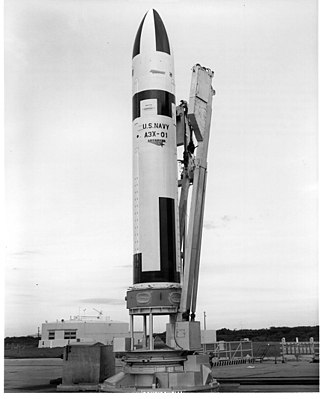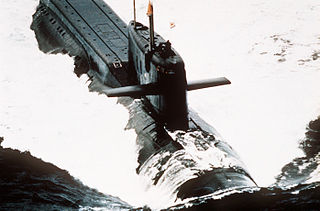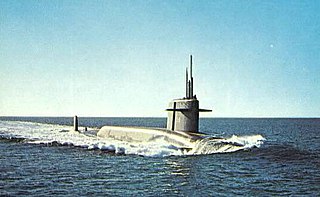
The Benjamin Franklin-class submarine was a group of US ballistic missile submarines that were in Navy service from the 1960s–2000s. The class was an evolutionary development from the earlier James Madison class of fleet ballistic missile submarine. Having quieter machinery and other improvements, it is considered a separate class. A subset of this class is the re-engineered 640 class starting with USS George C. Marshall. The primary difference was that they were built under the new SUBSAFE rules after the loss of USS Thresher, earlier boats of the class had to be retrofitted to meet SUBSAFE requirements. The Benjamin Franklin class, together with the George Washington, Ethan Allen, Lafayette, and James Madison classes, comprised the "41 for Freedom" that was the Navy's primary contribution to the nuclear deterrent force through the late 1980s. This class and the James Madison class are combined with the Lafayettes in some references.

The UGM-27 Polaris missile was a two-stage solid-fueled nuclear-armed submarine-launched ballistic missile (SLBM). As the United States Navy's first SLBM, it served from 1961 to 1980.

A submarine-launched ballistic missile (SLBM) is a ballistic missile capable of being launched from submarines. Modern variants usually deliver multiple independently targetable reentry vehicles (MIRVs), each of which carries a nuclear warhead and allows a single launched missile to strike several targets. Submarine-launched ballistic missiles operate in a different way from submarine-launched cruise missiles.

USS Patrick Henry (SSBN-599), named after the American Revolutionary War figure and Founding Father Patrick Henry (1736–1799), was a George Washington class nuclear-powered fleet ballistic missile submarine of the United States Navy. She was later converted into an attack submarine and redesignated SSN-599.

A ballistic missile submarine is a submarine capable of deploying submarine-launched ballistic missiles (SLBMs) with nuclear warheads. These submarines became a major weapon system in the Cold War because of their nuclear deterrence capability. They can fire missiles thousands of kilometers from their targets, and acoustic quieting makes them difficult to detect, thus making them a survivable deterrent in the event of a first strike and a key element of the mutual assured destruction policy of nuclear deterrence.

USS George Washington (SSBN-598) was the United States's first operational ballistic missile submarine. She was the lead ship of her class of nuclear ballistic missile submarines, was the third United States Navy ship of the name, in honor of Founding Father George Washington (1732–1799), the first president of the United States, and was the first of that name to be purpose-built as a warship.

The George Washington class was a class of nuclear-powered ballistic missile submarines deployed by the United States Navy. George Washington, along with the later Ethan Allen, Lafayette, James Madison, and Benjamin Franklin classes, comprised the "41 for Freedom" group of submarines that represented the Navy's main contribution to the nuclear deterrent force through the late 1980s.

41 for Freedom refers to the US Navy Fleet Ballistic Missile (FBM) submarines from the George Washington, Ethan Allen, Lafayette, James Madison, and Benjamin Franklin classes. All of these submarines were commissioned 1959–1967, as the goal was to create a credible, survivable sea-based deterrent as quickly as possible. These submarines were nicknamed "41 for Freedom" once the goal of 41 nuclear-powered ballistic missile submarines (SSBNs) was established in the early 1960s. The 1972 SALT I Treaty limited the number of American submarine-launched ballistic missile tubes to 656, based on the total missile tubes of the forty-one submarines, in line with the treaty's goal of limiting strategic nuclear weapons to the number already existing.

The Yankee class, Soviet designations Project 667A Navaga (navaga) and Project 667AU Nalim (burbot), was a series of nuclear-powered ballistic missile submarines built in the Soviet Union for the Soviet Navy. In total, 34 units were built: 24 in Severodvinsk for the Northern Fleet and the remaining 10 in Komsomolsk-on-Amur for the Pacific Fleet. Two Northern Fleet units were later transferred to the Pacific. The lead boat K-137 Leninets received its honorific name on 11 April 1970, two and one half years after being commissioned.

USS Ethan Allen (SSBN-608), lead ship of her class, was the second ship of the United States Navy to be named for American Revolutionary War hero Ethan Allen.

USS Thomas A. Edison (SSBN-610), an Ethan Allen-class nuclear-powered ballistic missile submarine, was the second ship of the United States Navy to be named for the inventor, Thomas Edison (1847–1931).

USS John Marshall (SSBN-611) was an Ethan Allen-class submarine, the only ship of the United States Navy to be named for John Marshall (1755–1835), the fourth Chief Justice of the United States. Originally a fleet ballistic missile submarine designated SSBN-611, she later was reclassified as an attack submarine and re-designated SSN-611.

The Lafayette class of submarine was an evolutionary development from the Ethan Allen class of fleet ballistic missile submarine, slightly larger and generally improved. This class, together with the George Washington, Ethan Allen, James Madison, and Benjamin Franklin classes, composed the "41 for Freedom," the Navy's primary contribution to the nuclear deterrent force through the late 1980s. The James Madison and Benjamin Franklin classes are combined with the Lafayettes in some references.

The James Madison class of submarine was an evolutionary development from the Lafayette class of fleet ballistic missile submarine. They were identical to the Lafayettes except for being initially designed to carry the Polaris A-3 missile instead of the earlier A-2. This class, together with the George Washington, Ethan Allen, Lafayette, and Benjamin Franklin classes, composed the "41 for Freedom" that was the Navy's primary contribution to the nuclear deterrent force through the late 1980s. This class and the Benjamin Franklin class are combined with the Lafayettes in some references.

The SSBN Deterrent Patrol Insignia is a uniform breast pin worn by officers and enlisted sailors of the United States Navy's submarine service who have completed strategic deterrent patrols in nuclear ballistic or cruise missile submarines. It is awarded for different criteria than the Submarine Combat Patrol Insignia awarded for submarine patrols during World War II. Design of the SSBN pin shows a silver Lafayette-class submarine with superimposed Polaris missile and electron rings which signify the armament and nuclear-powered characteristics of the Fleet Ballistic Missile Deterrent Force. A scroll beneath the submarine holds up to six award stars, with one gold star authorized for each successful patrol, or a silver star for five successful patrols. At twenty (20) successful patrols, the SSBN pin is upgraded to a gold design. This insignia qualifies the veteran as a combat veteran, making the veteran eligible to join the VFW.

USS Sam Rayburn (SSBN-635) was a James Madison-class fleet ballistic missile submarine named for Sam Rayburn (1882–1961), Speaker of the United States House of Representatives. Sam Rayburn was in commission 2 December 1964 to 31 July 1989 carrying the Polaris missile and later the Poseidon missile. Following decommissioning, ex-Sam Rayburn was converted into a moored training ship for use at the Naval Nuclear Prototype Training Unit at Goose Creek, South Carolina.
There are three major types of submarines in the United States Navy: ballistic missile submarines, attack submarines, and cruise missile submarines. All submarines currently in the U.S. Navy are nuclear-powered. Ballistic missile submarines have a single strategic mission of carrying nuclear submarine-launched ballistic missiles. Attack submarines have several tactical missions, including sinking ships and subs, launching cruise missiles, and gathering intelligence. Cruise missile submarines perform many of the same missions as attack submarines, but with a focus on their ability to carry and launch larger quantities of cruise missiles than typical attack submarines.
The UGM-89 Perseus was a proposed U.S. Navy submarine-launched anti-ship (AShM) and anti-submarine (ASW) cruise missile that was developed under the Submarine Tactical Missile (STAM) project, which was also referred to as the Submarine Anti-ship Weapon System (STAWS). This missile system was to be the centerpiece for a proposed third-generation nuclear-powered cruise missile submarine championed by then-Vice Admiral Hyman G. Rickover, the influential but controversial head of the Navy's nuclear propulsion program.

Submarine Squadron 15 is a squadron of submarines of the United States Navy based at Naval Base Guam.

United States Navy Special Projects Office (SPO) is a former research and design office of the United States Navy, responsible for the coordination of the development and design of the US Navy Fleet Ballistic Missiles (FBM) Polaris and Poseidon.















